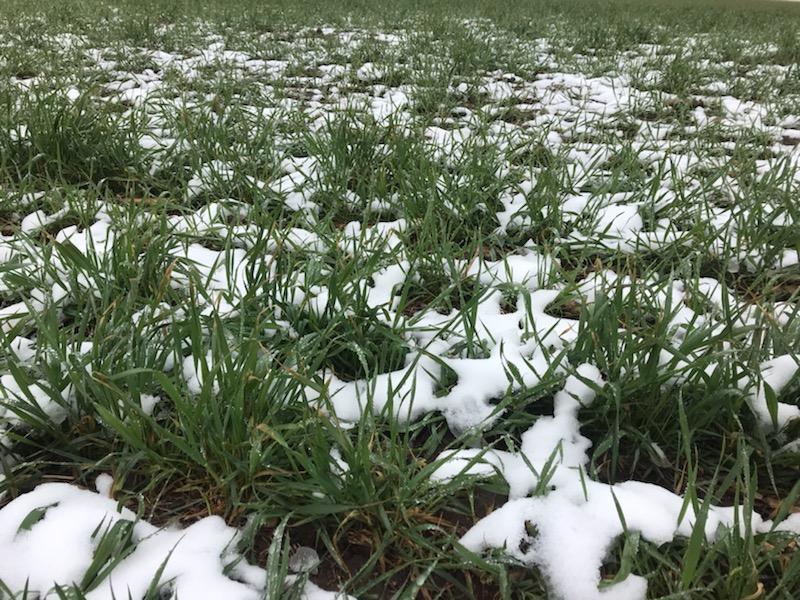
Assessing Freeze Injury to Winter Wheat
With recent low temperatures, wheat growers are concerned about potential freeze injury. During the overnight hours of May 1-2, the temperature was below 28°F for 10 hours at Harrison, seven hours at Sidney, and five hours at Whitman. Growers can expect to see damage to leaf tips from these cold temperatures, but as much of the crop hadn't jointed yet, extensive damage is not expected. It can take up to five days for damage to become visible.
As of April 28, the National Agricultural Statistics Service reported the condition of Nebraska’s winter wheat crop to be 3% excellent, 65% good, 28% fair, 3% poor, and 1% very poor.
In 1981 Red Willow County (McCook) experienced low temperatures on May 9-10 and suffered the highest losses for the state. Winter wheat had just headed when temperatures dropped to 28° F and slowly warmed to 37° F over four hours. Decatur County, Kansas, which adjoins Red Willow County (McCook), suffered the highest losses in the state. In late May 1992 winter wheat and other crops also suffered major losses due to a freeze.

Figure 1 and Table 1 show the effect of freezing temperatures at various growth stages of wheat.
Through experience, we know that injury does not always occur at the air temperature listed. Injury is greatly influenced by duration of the low temperature and growth stage of the wheat. Before the head is exposed, it benefits from the microclimate in the wheat canopy, and temperatures there may not be as low as the air temperatures reported. Once the wheat is headed, it is subject to the air temperature; hence, injury usually occurs at the temperatures indicated in Figure 1 and Table 1.
Since it takes several days of warm weather for freeze injury to become apparent, wait five days or so after a freeze and then assess plant damage.
Microclimate Factors Affecting Wheat Injury
While the air temperature may drop for several hours, the actual microclimate of the crop may be several degrees warmer and create a "cushion" of protection to help moderate temperature swings. Factors besides air temperature affecting the potential for damage include:
- Crop condition — The advanced growth stage increases winter injury. Also, many winter wheat stands are already thin due to winter injury, making plants more susceptible to freeze injury.
- Soil moisture — Generally, if the topsoil is moist, it helps limit temperature changes. (Several years ago when there was a hard freeze in the Republican Valley in June, the cultivated corn with dry topsoil suffered significantly more damage than the non-cultivated corn.)
- Duration of the chill — Figure 1 and Table 1 are for temperatures of two hours duration.
The many factors influencing freeze injury to wheat — plant growth stage, plant moisture content, and duration of exposure — often make it difficult to predict the extent of injury too quickly. This is complicated further by differences in elevation and topography among wheat fields and between the fields and official weather stations. It is not unusual, for instance, for wheat growers to report markedly lower temperatures than are recorded at the nearest official weather station.
Areas that may have been particularly susceptible to the temperatures are low field areas, thin stands, and dry soil.
| Growth Stage | Approximate Injurious Temperature (Two Hours) | Primary Symptoms | Yield Effect |
| Tillering | 12°F | Leaf chlorosis; burning of leaf tips; silage odor; blue cast to fields | Slight to moderate |
| Jointing | 24°F | Death of growing point; leaf yellowing or burning; lesions, splitting, or bending of lower stem; odor | Moderate to severe |
| Boot | 28°F | Floret sterility; head trapped in boot; damage to lower stem; leaf discoloration; odor | Moderate to severe |
| Heading | 30°F | Floret sterility; white awns or white heads; damage to lower stem; leaf discoloration | Severe |
| Flowering | 30°F | Floret sterility; wheat awns or white heads; damage to lower stem; leaf discoloration | Severe |
| Milk | 28°F | White awns or white heads; damage to lower stems; leaf discoloration; shrunken, roughened, or discolored kernels | Moderate to severe |
| Dough | 28°F | Shriveled, discolored kernels; poor germination | Slight to moderate |
Assessing Damage
To check for head damage, wait for three or four warm days and then split some plant stems lengthwise with a sharp knife. A normal, uninjured head is bright yellow-green and turgid (firm) (Figure 2, left), whereas freeze injury causes the head to become white or brown and water-soaked in appearance (Figure 2, right). This injury can occur even in plants that appear otherwise normal because the head is more sensitive to cold than other plant parts.
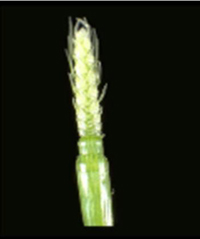
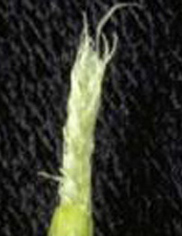
Figure 2. After a hard freeze, wait for three or four warm days to assess wheat damage. Split the stem lengthwise with a sharp knife to view the head. Shown are a healthy growing point with a crisp, whitish-green appearance (left) and one that has freeze injury. A growing point that has been damaged loses its turgidity and greenish color within several days after a freeze and may turn white or brown and appear water-soaked. A hand lens may be needed to help detect subtle freeze damage symptoms.
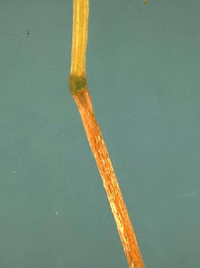
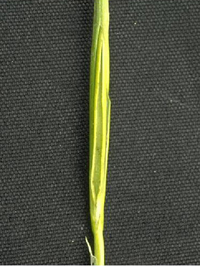
Figure 3. (left) Discoloring and roughening of the lower stem are symptoms of spring freeze damage. (right) The stem can split with severe freeze damage.
Stem growth stops immediately when the head is injured, but growth from later tillers may obscure damage. Partial injury at this stage may cause a mixture of normal tillers and late tillers and result in uneven maturity and some decrease in grain yield.
Freezing temperatures at this stage of development also can cause leaf injury, which is typically expressed as twisted leaves and a change in leaf color from dark green to light green or yellow. Leaf tips may become necrotic or "burned" by freezing temperatures. Leaf injury does not usually result in significant yield losses, as new leaf and tiller growth resumes with warmer temperatures.
Injury to the lower stems in the form of discoloration, roughness, lesions, splitting, collapse of internodes, and enlargement of nodes frequently occurs at the jointing stage and the following stages after freezing (Figure 3). Injured plants may break over at the affected areas of the lower stem so that one or two internodes are parallel to the soil surface.
Stem injury does not appear to seriously interfere with the ability of wheat plants to take up nutrients from the soil and translocate them to the developing grain. Lodging, or falling over, of plants, is the most serious problem following stem injury. Wind or hard rain near maturity will easily lodge the plants, decreasing grain yield and slowing harvest.
If the wheat is flowering or just past flowering when frost hits, wheat damage is not easily identified. The exposed anthers are most susceptible to the freeze. In general, it is only possible to evaluate seed fill by dissecting heads 10-14 days after the frost. If there are many blank glumes or kernels are not developing, damage is indicated.
Sometimes we see stems that have ruptured during a freeze and the head turns white on the next hot dry day.
For more information on how to assess freeze injury in winter wheat, see Freeze Injury to Nebraska Wheat (EC132) and CropWatch.unl.edu/wheat).
Online Master of Science in Agronomy
With a focus on industry applications and research, the online program is designed with maximum flexibility for today's working professionals.
